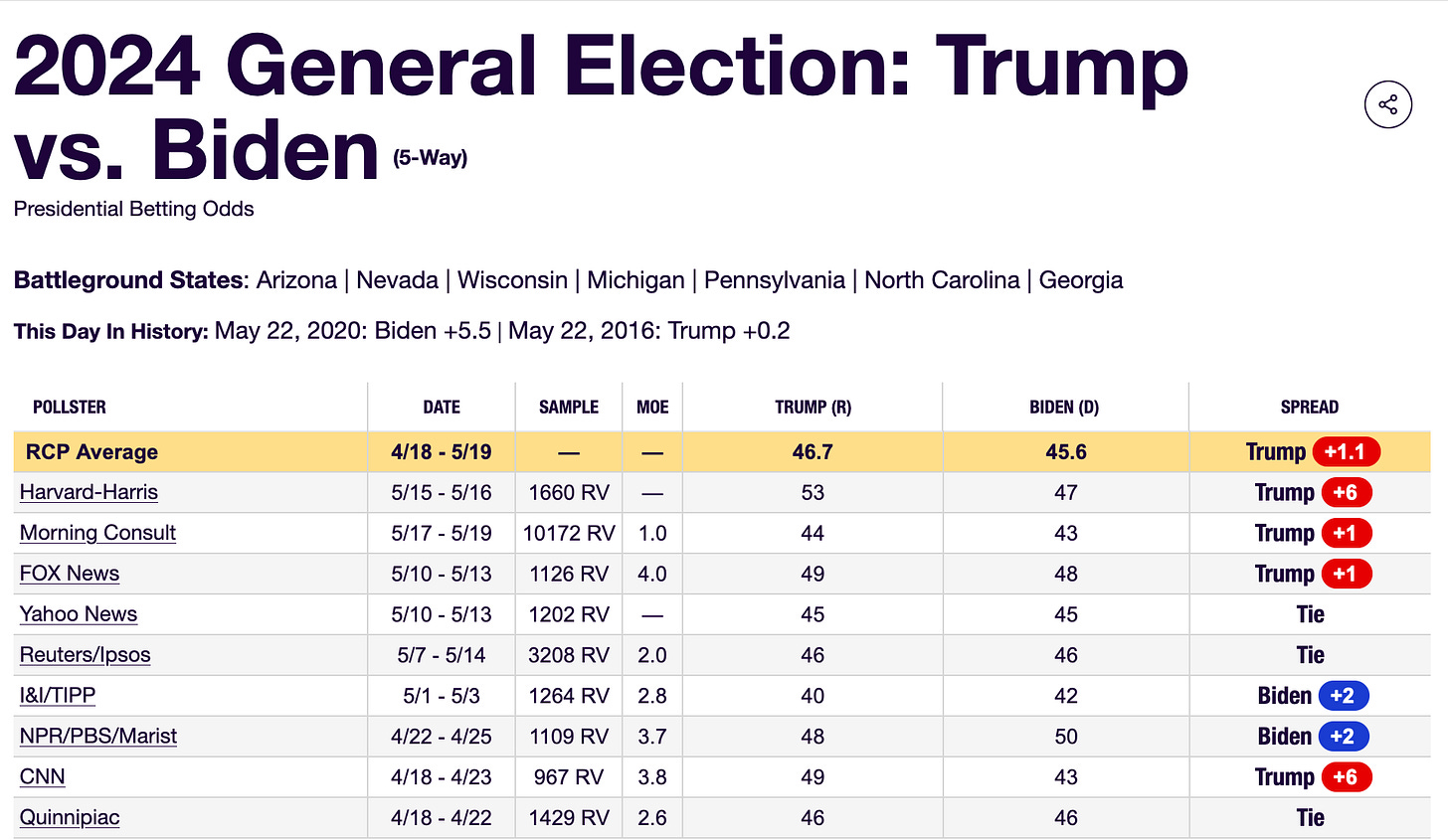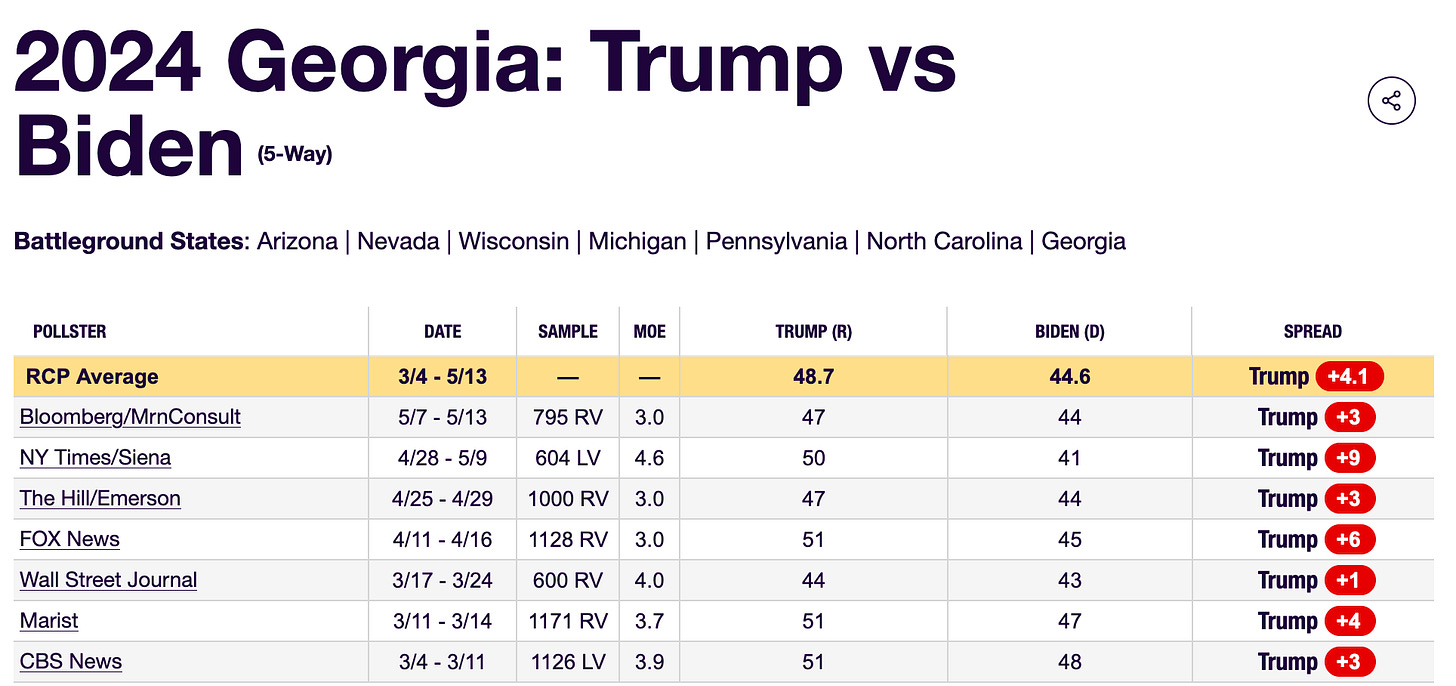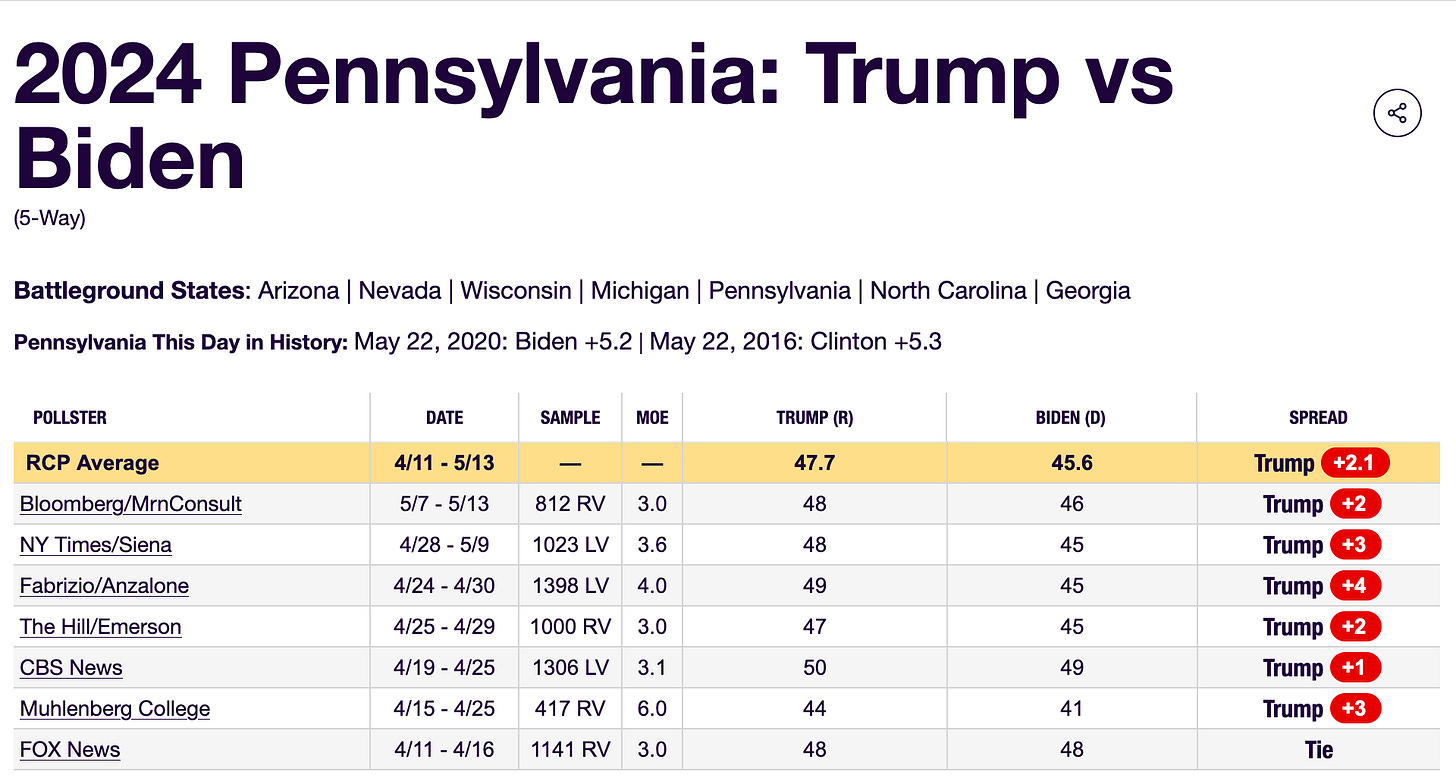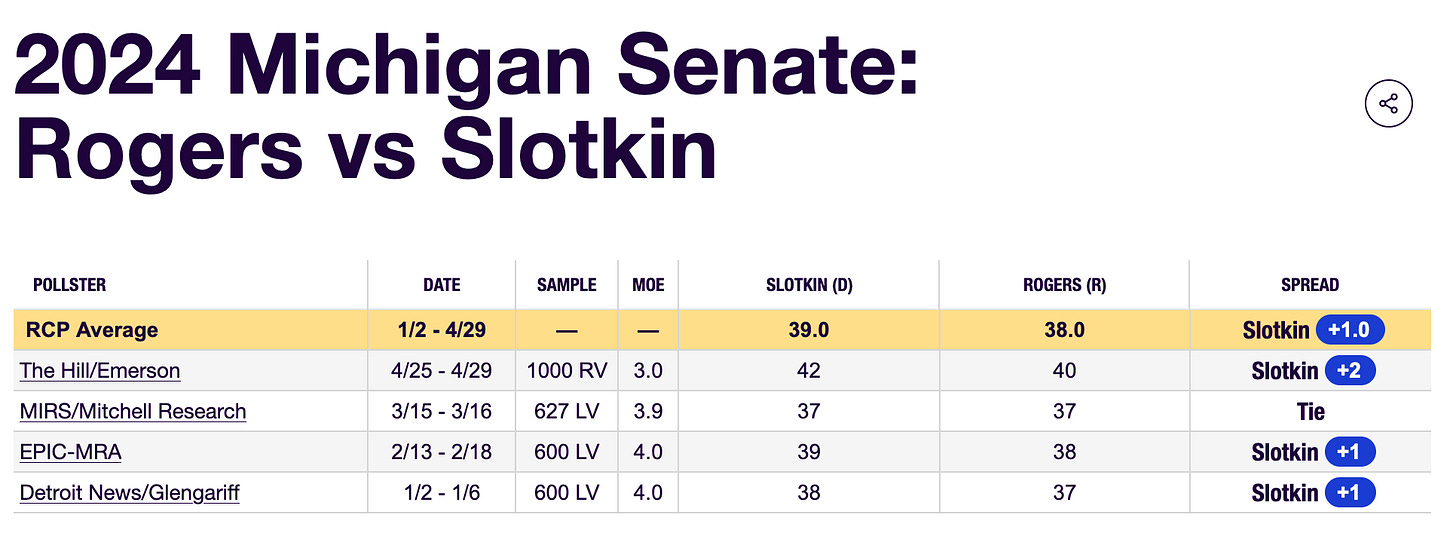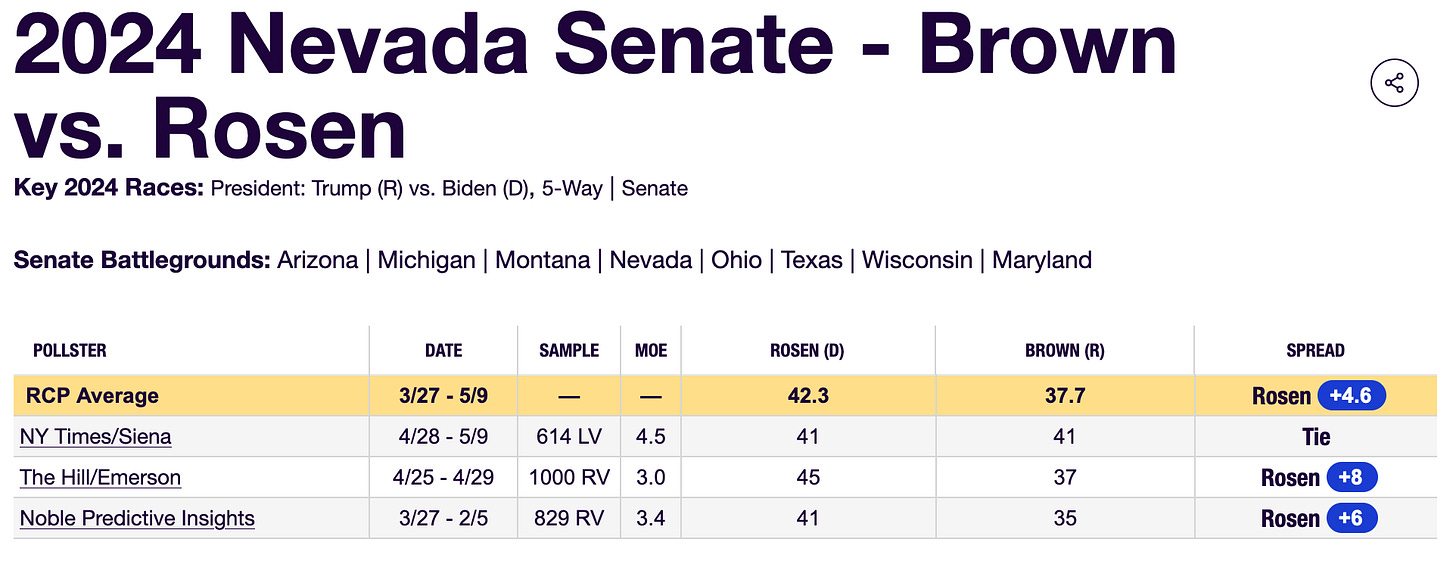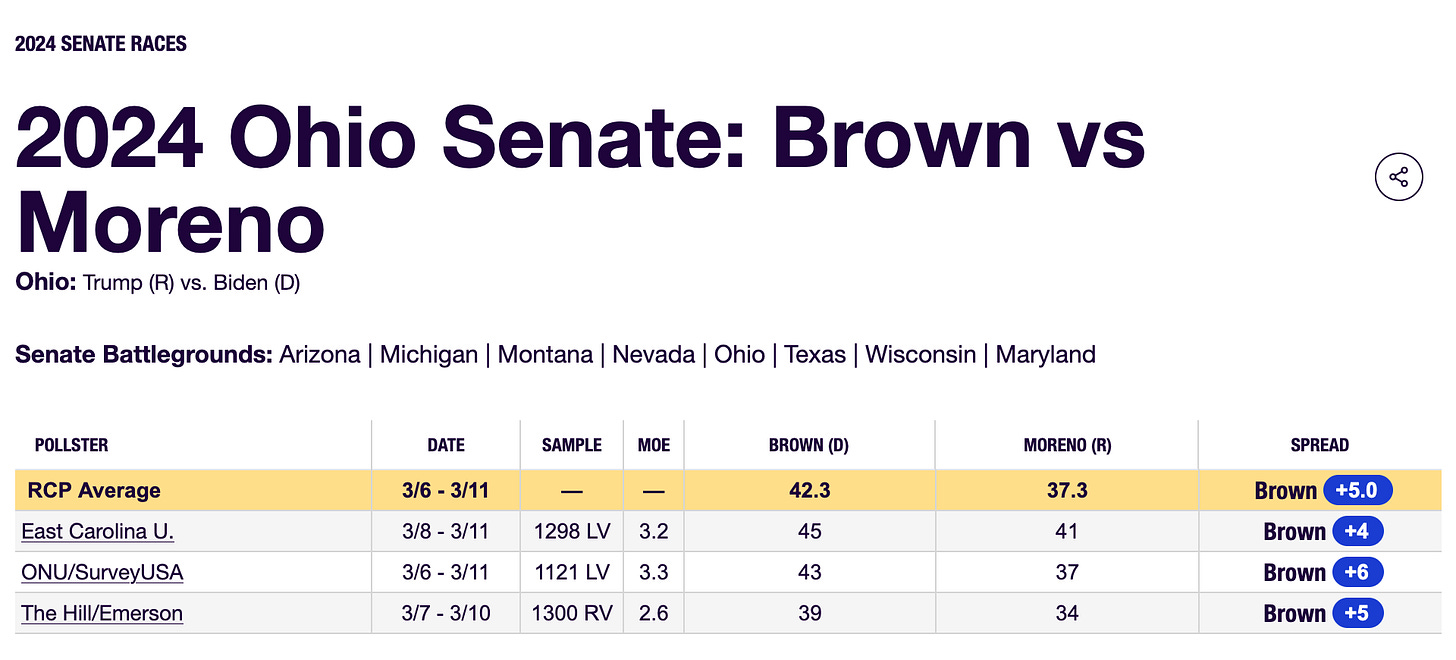Current Polling Shows a Donald Trump Win With Thin Republican Control of the U.S. Senate
So what do the current polling results in all of these races tell us?
The General Election national polling shows a +1.1 Donald Trump lead. As I’ve noted before, the Democrat presidential candidate needs to be UP by roughly 4% or more to win the Electoral College given the oversampling that occurs due to California, Illinois, New Jersey, and New York being so heavily Democrat and populous. If Trump maintains his national polling advantage, it is possible he not only wins the Electoral College, but also the national popular vote over Joe Biden.
In terms of battleground state polling, in Arizona, Trump leads by a solid +4.6 points. Barring something unexpected, Arizona will return to being a Red state in 2024.
In Georgia, Trump is ahead by +4.1, which is a strong position from his razor thin loss in 2020. Like Arizona, Georgia will go Red again in 2024.
In Michigan, Trump leads by +1.0, with polls jumping back and forth between the two candidates. As I noted last September in “Can Donald Trump Win in 2024?”, Michigan is one of the three tough challenges for Trump/Republicans. Even though Trump is doing better in Michigan currently, I do expect Biden to win it in November because of Democrat Governor Gretchen Witmer’s efforts (legitimate and otherwise) and Big Labor.
In Nevada, Trump leads by a surprising +4.6 points. I say “surprising” not because Trump is winning, but because he is winning by such a big margin. If this margin holds, then you should expect to see Trump win a solid minority or even majority of Hispanic voters nationally.
In North Carolina, Trump leads by a beyond-the-margin-of-error amount at +4.8 points. North Carolina is not going to be heavily contested come the Fall, as Trump will win it, which the Democrats know.
In Pennsylvania, Trump leads by +2.1 points. Like Michigan, Pennsylvania is a tough one for Trump/Republicans because of the heavy Democrat voting areas in the Philadelphia and Pittsburgh areas. As with Nevada, if Trump wins Pennsylvania in November, expect him to perform strongly with black voters nationally.
In Wisconsin, Trump leads by just +0.1, with Biden’s only lead in an outlier Quinnipiac poll showing him up by +6.0 points. Wisconsin will be ground zero for the November election given how tight it has been over the last two presidential elections. Biden must win Wisconsin, along with Michigan and Pennsylvania, in order to win reelection. The loss of one ends his reelection bid.
If these leads hold until November, Trump would win back the presidency with a 312-226 Electoral Vote victory. It is more likely, however, Trump will win 278-260 or 293-245 margin.
In contrast, except for flipping West Virginia from Democrat to Republican thereby putting control at 50-50, the various U.S. Senate polls show a much tighter race for control of that chamber. Specifically, other than in Maryland, the Democrat candidates currently lead in all of the seven top races.
In Arizona, Democrat Ruben Gallego sits with a hefty +6.0 point lead over Republican Kari Lake. Gallego’s lead is much larger than the 2-point win Democrat-now-Independent Senator Kyrsten Sinema won by in 2018.
In Maryland, former Republican Governor Larry Hogan heads into the general election with a +6.5-point led over Democrat Angela Alsobrooks. While that might sound good for the Right, it isn’t. Hogan already has stated, “In the Senate, Republicans can’t count on my vote.” I’m not a fan of purist politics, especially in the U.S. Senate given how difficult it is to get and keep control, but, if Hogan is the vote that Trump might need on a key vote, his hatred towards Trump likely will push him to pull a John McCain instead of supporting the Trump agenda. The Right has had enough of the McCains, Lisa Murkowskis, and Susan Collins. It needs members who will loyally support the Trump agenda, which the vast majority of Republicans support. Thus, the Right should provide Hogan with ZERO funding for his campaign and direct all funds to the other races noted in this column.
In Michigan, Democrat Elissa Slotkin has a small +1.0 point lead over Republican Mike Rogers. Slotkin’s small lead is less than the 6.5-point win incumbent Democrat Senator Debbie Stabenow had in 2018. This shrinkage likely indicates Michigan is trending back to the right in 2024. Will that shift be big enough to secure Trump and Rogers wins in November? Only time will tell.
In Montana, incumbent Democrat Joe Tester leads Republican Tim Sheehy by +5.5-points. Tester’s lead is two points greater than his 2018 reelection win. Tester is the big white whale (literally) that Republicans have hunted for years given how red Montana is. My sense is Tester’s strong name ID and long history with Montanans will push him across the line again in 2024.
In Nevada, incumbent Democrat Jacky Rosen is ahead of Republican Sam Brown by +4.6 points. Rosen’s current lead roughly matches her 2018 win. This race more than any other race shows the ticket-splitting reality the Left faces in 2024, with left-leaning voters ditching Biden, but sticking with the party on the rest of the ticket.
In Ohio, with little public polling since March, incumbent Democrat Sherrod Brown is up +5.0 points over Republican Bernie Moreno. Brown’s lead is just below his 6-point margins in 2012 and 2018. I think Moreno’s chances rest largely on how well Trump does in Ohio in 2024. If Trump can go beyond his eight-point wins in 2016 and 2020, then Moreno stands a solid chance of pulling the upset over Brown. If, however, Trump’s win matches his past performance, then Brown likely will squeak by in 2024 largely due to his longstanding relationship with blue collar Trump Democrats. One unknown in this race is the fact that for the first time, Brown is running for reelection in an anti-Democrat year presidentially. He won in 2006 on the anti-George Bush/Iraq War Democrat wave; he won reelection in 2012 on Barack Obama’s reelection wave; and he won again in 2018 during a Trump mid-term election.
In Pennsylvania, incumbent Democrat Bob Casey, Jr., sits with a +4.8 point lead over Republican David McCormick. Casey’s current lead is significantly below his 13-point win in 2018. Like Michigan, this shift to the Right indicates how Pennsylvania is really a purple state and also could signal that the predicted Trump appeal to black voters is real.
In Wisconsin, incumbent Democrat Tammy Baldwin is leading Eric Hovde by +6.8 points. Baldwin’s lead is 3-points lower than her 2018 win. Baldwin is likely being hurt by anti-Biden sentiment, but, as with Nevada, likely will survive due to conscious ticket splitters going one way presidentially (Trump) and another way down ticket (Democrats).
If these numbers hold, then Republicans will take back the U.S. Senate, but that control will depend on either Hogan or Trump winning the presidency so his Vice President casts the tie vote for Republicans in a 50-50 chamber. Perhaps a surprise will happen in Michigan or Ohio to make Hogan’s vote less powerful, but I wouldn’t count on it.
So what do the current polling results in all of these races tell us? I think the punchlines from comparing presidential and U.S. Senate polling are that (1) anti-Biden sentiment is real, (2) Trump nostalgia also is real, and (3) ticket-splitting will be more prevalent in 2024 than in 2016 and 2020.




